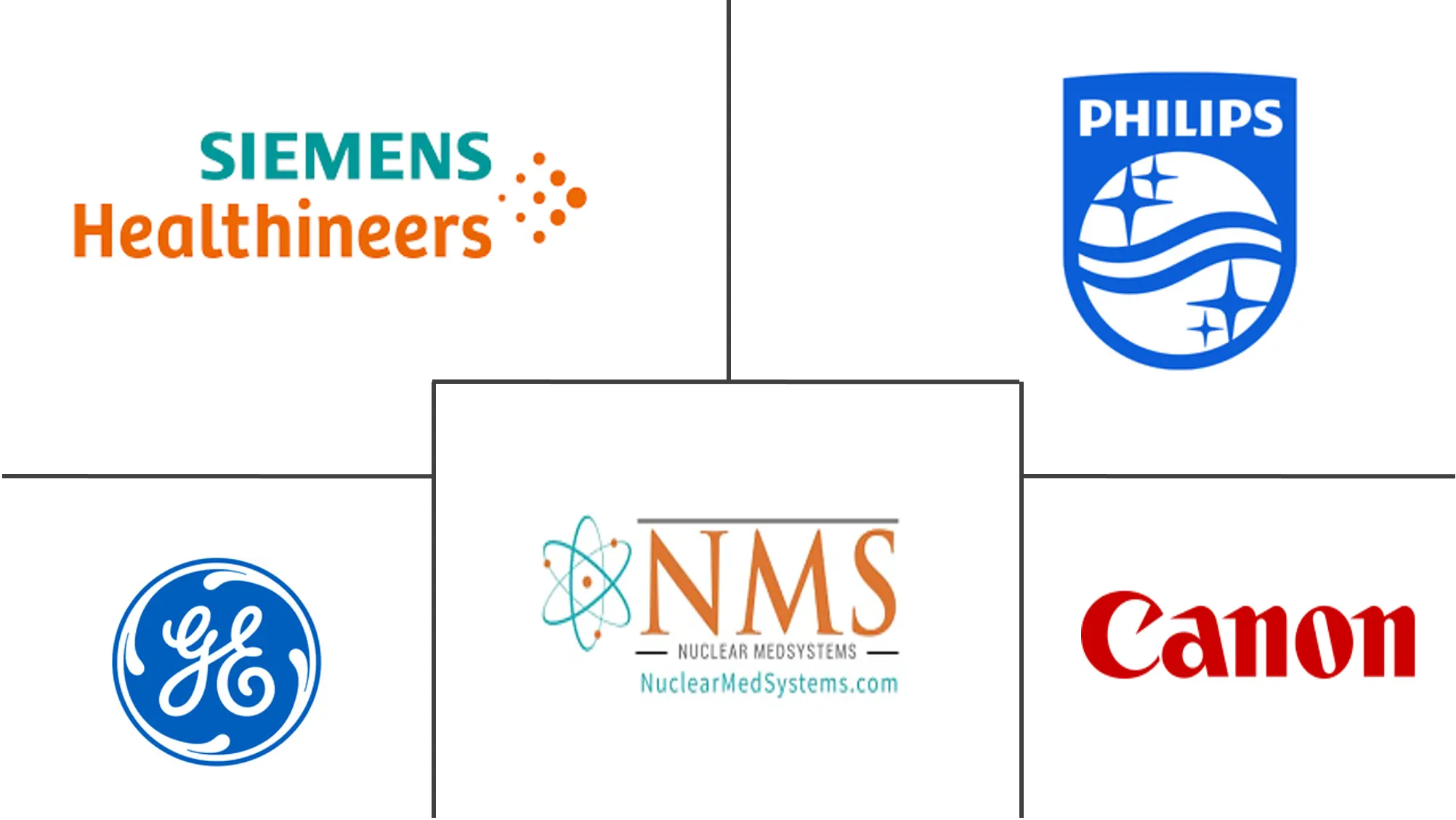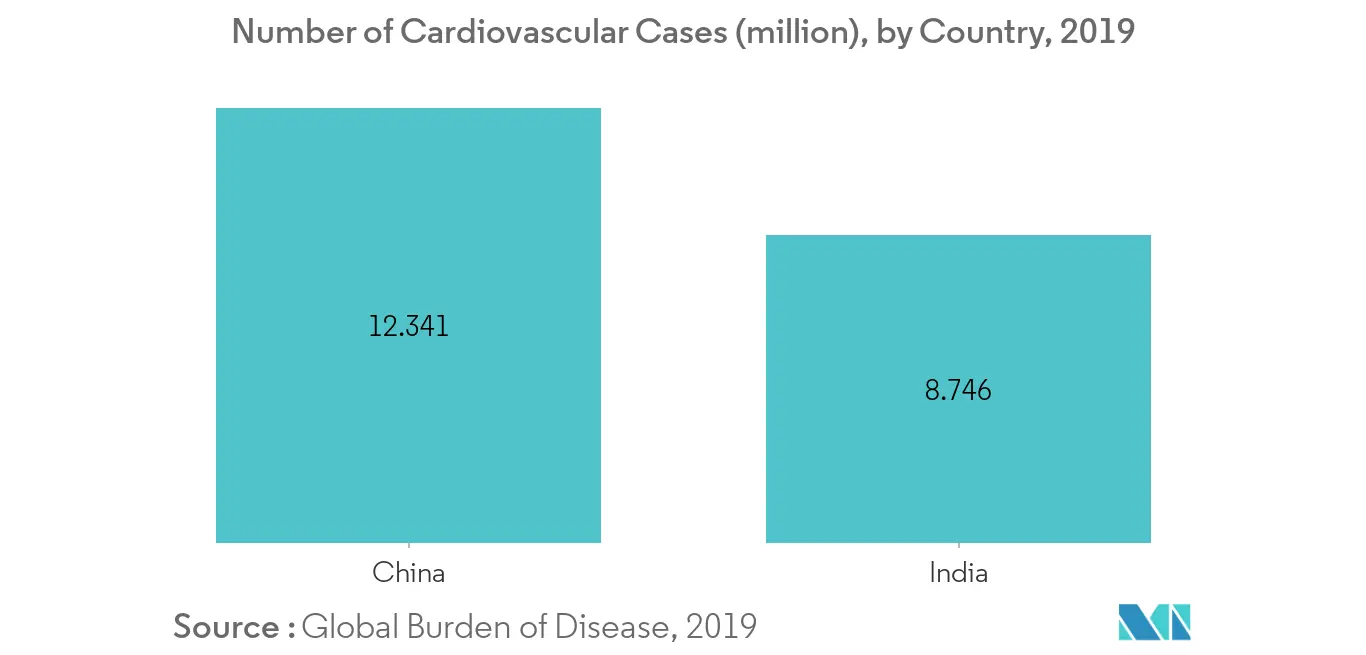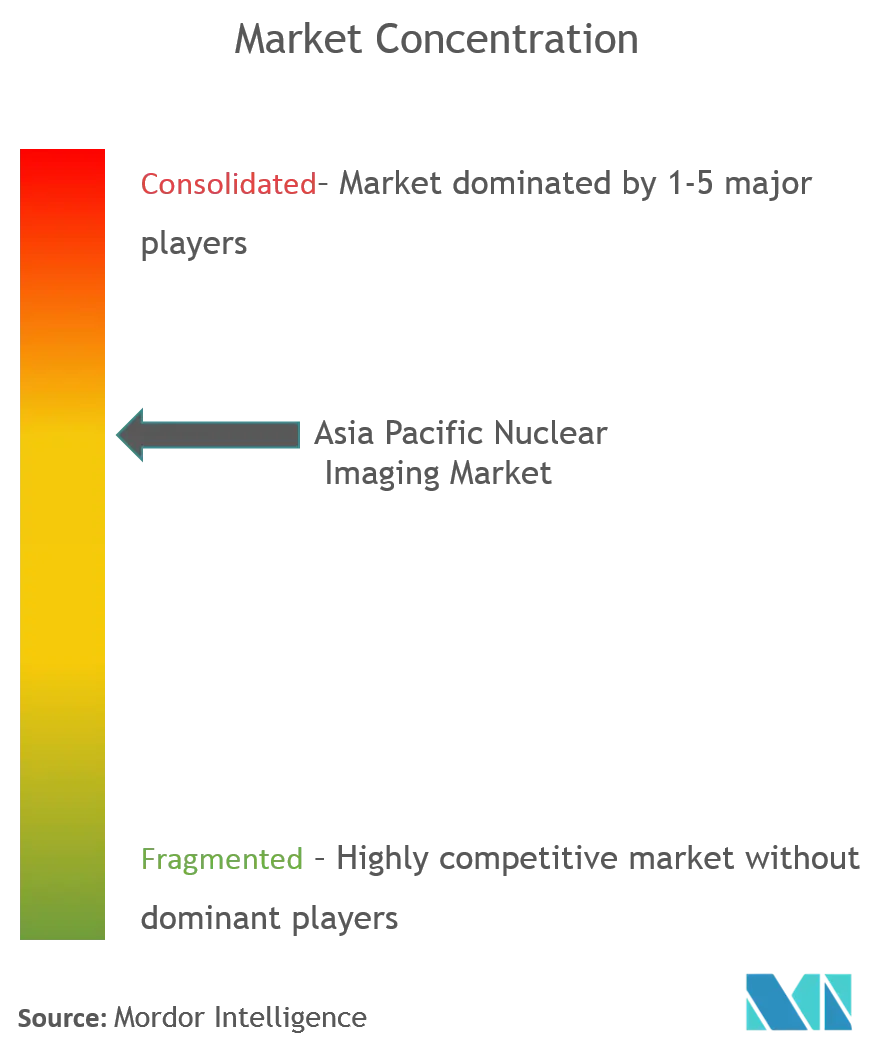APAC Nuclear Imaging Devices Market Size

| Study Period | 2019 - 2029 |
| Base Year For Estimation | 2023 |
| Forecast Data Period | 2024 - 2029 |
| Market Size (2024) | USD 1.52 Billion |
| Market Size (2029) | USD 1.88 Billion |
| CAGR (2024 - 2029) | 4.23 % |
Major Players
*Disclaimer: Major Players sorted in no particular order |
APAC Nuclear Imaging Devices Market Analysis
The Asia Pacific Nuclear Imaging Market size is estimated at USD 1.52 billion in 2024, and is expected to reach USD 1.88 billion by 2029, growing at a CAGR of 4.23% during the forecast period (2024-2029).
The factors that are propelling the growth of the market include technological advancements, increasing diagnostic applications in various diseases, such as cancer and cardiovascular diseases, and the growing burden of these chronic diseases.
Over recent years, scientists, researchers, and technologists have been able to bring systems in clinical practice, in which two or even more than two standalone diagnostic imaging modalities are combined. Some of those multimodality imaging systems include PET/CT, SPECT/CT, PET/MRI, and PET/SPECT/CT. The shift from standalone to hybrid modalities have improved the applications of these devices in recent times.
Moreover, the rise in the prevalence of cancer and cardiac ailments is one of the primary drivers for the market. Nuclear medicine is hugely capable of treating cancer and cardiac diseases. Asia Pacific region has the highest populous countries like China and India, which in turn contribute to a large aging population. There is also a higher disease incidence in this region increases the demand for advanced technologies like nuclear imaging. There is a large investment on the healthcare setup and medical research making these facilities accessible. The per capita income is increasing in these countries making such technologies more affordable.
APAC Nuclear Imaging Devices Market Trends
This section covers the major market trends shaping the APAC Nuclear Imaging Market according to our research experts:
Cardiology is Expected to Hold the Highest Market Share in the Region
Cardiac nuclear medicine exams provide pictures of the distribution of blood flow to the heart muscle and can be used to visualize the function of the heart. This technique has applications in the diagnosis of various cardiovascular diseases such as angina, aneurysm, atherosclerosis, stroke, coronary artery disease, and congestive heart failure. It is also used to evaluate cardiomyopathy and identify possible damage to the heart from chemotherapy or radiotherapy.
As per a 2019 report by Prabha Desikan et al, published in Circulation: Cardiovascular Quality and Outcomes, CVDs are the leading cause of mortality in India. This epidemiological transition is large because of the increase in the prevalence of CVDs and CVD risk factors in India.
Gamma cameras and positron emission tomography scanners are the major imaging devices used in cardiac procedures. SPECT imaging has been the mainstream modality for nuclear cardiology procedures performed worldwide.
Therefore the increasing prevalence of cardiovascular diseases is found contributing to the growth of the market for nuclear imaging equipment.

APAC Nuclear Imaging Devices Industry Overview
The Asia Pacific nuclear imaging market is highly competitive and consists of a few major players. In terms of market share, few of the major players currently dominate the market. Companies, like Koninklijke Philips NV, GE Healthcare, and Siemens Healthineers, among others, hold a substantial share in the market.
APAC Nuclear Imaging Devices Market Leaders
-
Canon Medical Systems Corporation
-
Siemens Healthineers
-
Koninklijke Philips NV
-
GE Healthcare
-
Neusoft Medical Systems Co., Ltd.
*Disclaimer: Major Players sorted in no particular order

APAC Nuclear Imaging Devices Market Report - Table of Contents
-
1. INTRODUCTION
-
1.1 Study Deliverables
-
1.2 Study Assumptions
-
1.3 Scope of the Study
-
-
2. RESEARCH METHODOLOGY
-
3. EXECUTIVE SUMMARY
-
4. MARKET DYNAMICS
-
4.1 Market Overview
-
4.2 Market Drivers
-
4.2.1 Rise in Prevalence of Cancer and Cardiac Disorders
-
4.2.2 Increase in Technological Advancements
-
-
4.3 Market Restraints
-
4.3.1 Limited Reimbursement and Stringent Regulatory Procedures
-
-
4.4 Porter's Five Force Analysis
-
4.4.1 Threat of New Entrants
-
4.4.2 Bargaining Power of Buyers/Consumers
-
4.4.3 Bargaining Power of Suppliers
-
4.4.4 Threat of Substitute Products
-
4.4.5 Intensity of Competitive Rivalry
-
-
-
5. MARKET SEGMENTATION
-
5.1 By Product Type
-
5.1.1 Equipment
-
5.1.2 Radioisotope
-
5.1.2.1 SPECT Radioisotopes
-
5.1.2.1.1 Technetium-99m (TC-99m)
-
5.1.2.1.2 Thallium-201 (TI-201)
-
5.1.2.1.3 Gallium(Ga-67)
-
5.1.2.1.4 Iodine (I-123)
-
5.1.2.1.5 Other SPECT Radioisotopes
-
-
5.1.2.2 PET Radioisotopes
-
5.1.2.2.1 Fluorine-18 (F-18)
-
5.1.2.2.2 Rubidium-82 (RB-82)
-
5.1.2.2.3 Other PET Radioisotopes
-
-
-
-
5.2 By Application
-
5.2.1 SPECT Applications
-
5.2.1.1 Cardiology
-
5.2.1.2 Neurology
-
5.2.1.3 Thyroid
-
5.2.1.4 Other SPECT Applications
-
-
5.2.2 PET Applications
-
5.2.2.1 Oncology
-
5.2.2.2 Cardiology
-
5.2.2.3 Neurology
-
5.2.2.4 Other PET Applications
-
-
-
5.3 Geography
-
5.3.1 Asia-Pacific
-
5.3.1.1 China
-
5.3.1.2 Japan
-
5.3.1.3 India
-
5.3.1.4 Australia
-
5.3.1.5 South Korea
-
5.3.1.6 Rest of Asia-Pacific
-
-
-
-
6. COMPETITIVE LANDSCAPE
-
6.1 Company Profiles
-
6.1.1 Canon Medical Systems Corporation
-
6.1.2 Siemens Healthineers
-
6.1.3 Koninklijke Philips NV
-
6.1.4 GE Healthcare
-
6.1.5 Neusoft Medical Systems Co., Ltd.
-
6.1.6 MiE GmbH
-
6.1.7 Urenco
-
6.1.8 Taiyo Nippon Sanso
-
6.1.9 Bracco Imaging SpA
-
- *List Not Exhaustive
-
-
7. MARKET OPPORTUNITIES AND FUTURE TRENDS
APAC Nuclear Imaging Devices Industry Segmentation
Nuclear medicine imaging procedures are non-invasive, with the exception of intravenous injections, and are usually painless medical tests that help physicians diagnose and evaluate medical conditions. These imaging scans use radioactive materials called radiopharmaceuticals or radiotracers. These radiopharmaceuticals are used in diagnosis and therapeutics. They are small substances that contain a radioactive substance that is used in the treatment of cancer, cardiac and neurological disorders.
| By Product Type | ||||||||||||||
| Equipment | ||||||||||||||
|
| By Application | ||||||
| ||||||
|
| Geography | ||||||||
|
APAC Nuclear Imaging Devices Market Research FAQs
How big is the Asia Pacific Nuclear Imaging Market?
The Asia Pacific Nuclear Imaging Market size is expected to reach USD 1.52 billion in 2024 and grow at a CAGR of 4.23% to reach USD 1.88 billion by 2029.
What is the current Asia Pacific Nuclear Imaging Market size?
In 2024, the Asia Pacific Nuclear Imaging Market size is expected to reach USD 1.52 billion.
Who are the key players in Asia Pacific Nuclear Imaging Market?
Canon Medical Systems Corporation, Siemens Healthineers, Koninklijke Philips NV, GE Healthcare and Neusoft Medical Systems Co., Ltd. are the major companies operating in the Asia Pacific Nuclear Imaging Market.
What years does this Asia Pacific Nuclear Imaging Market cover, and what was the market size in 2023?
In 2023, the Asia Pacific Nuclear Imaging Market size was estimated at USD 1.46 billion. The report covers the Asia Pacific Nuclear Imaging Market historical market size for years: 2019, 2020, 2021, 2022 and 2023. The report also forecasts the Asia Pacific Nuclear Imaging Market size for years: 2024, 2025, 2026, 2027, 2028 and 2029.
Asia Pacific Nuclear Imaging Devices Industry Report
Statistics for the 2024 Asia Pacific Nuclear Imaging Devices market share, size and revenue growth rate, created by Mordor Intelligence™ Industry Reports. Asia Pacific Nuclear Imaging Devices analysis includes a market forecast outlook to 2029 and historical overview. Get a sample of this industry analysis as a free report PDF download.



